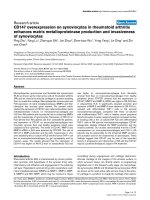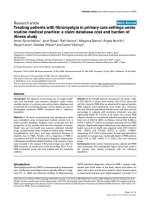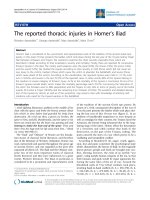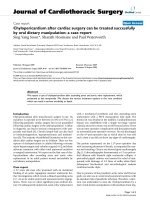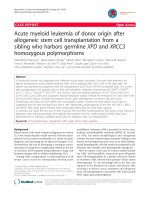Báo cáo y học: "Acute panuveitis with hypopyon in Crohn''''s disease secondary to medical therapy: a case report." pptx
Bạn đang xem bản rút gọn của tài liệu. Xem và tải ngay bản đầy đủ của tài liệu tại đây (240.98 KB, 3 trang )
BioMed Central
Page 1 of 3
(page number not for citation purposes)
Journal of Medical Case Reports
Open Access
Case report
Acute panuveitis with hypopyon in Crohn's disease secondary to
medical therapy: a case report
David Haider
2
, Felipe E Dhawahir-Scala*
2
, Nicholas G Strouthidis
1
and
Nigel Davies
1
Address:
1
Department of Ophthalmology, Chelsea and Westminster Hospital, Fulham Road, London, UK and
2
Manchester Royal Eye Hospital,
Oxford Road, Manchester, UK
Email: David Haider - ; Felipe E Dhawahir-Scala* - ;
Nicholas G Strouthidis - ; Nigel Davies -
* Corresponding author
Abstract
Background: A case report to highlight the association between rifabutin and hypopyon
Methods: A 56 year old male presented with a one day history of blurred vision in his right eye.
He had an established diagnosis of Crohn's disease which was in remission following treatment with
rifabutin and clarithromycin. A brisk anterior uveitis with hypopyon and a mild vitritis was detected
in the right eye. The acute inflammatory episode resolved following treatment with topical
corticosteroids and withdrawal of rifabutin.
Results: The presence of hypopyon is atypical in uveitis associated with inflammatory bowel
disease. The association between rifabutin treatment and hypopyon uveitis is well recognised in
Mycobacterium avium paratuberculosis. However, use of rifabutin in the management of Crohn's
disease is controversial and not widely known to an ophthalmic readership.
Conclusion: This report highlights the importance of keeping abreast of novel therapeutic
developments in systemic conditions likely to be encountered in ophthalmology.
Background
Crohn's disease is a chronic granulomatous inflammatory
disease which affects multiple sites throughout the gastro-
intestinal system. The ocular manifestations are protean
and commonly include episcleritis, scleritis and anterior
uveitis[1]. Retinal vasculitis, optic neuropathy and multi-
focal choroiditis have also been reported [2-4]. In this
report we describe a case of panuveitis with hypopyon in
a patient with Crohn's disease in whom the presentation
was attributable to a therapeutic agent and not the under-
lying systemic condition.
Methods
A 56 year old male attended the eye clinic having awoken
with blurred vision in his right eye; pain and photophobia
were not present. A 15 year history of Crohn's was
reported – this was in remission following a year-long trial
of 300 mg rifabutin daily with clarithromycin 250 mg
daily. Azathioprine had been discontinued by his rheu-
matologist 2 weeks previously. The patient had never
undergone gastro-intestinal surgery, there was no arthritis
and no previous history of uveitis. He was HLA-B27 nega-
tive. At presentation the best corrected visual acuity was 6/
24 OD and 6/6 OS. There was a right anterior uveitis with
4 mm hypopyon (Figure 1). The IOP was 12 mmHg in
Published: 4 July 2007
Journal of Medical Case Reports 2007, 1:42 doi:10.1186/1752-1947-1-42
Received: 11 March 2007
Accepted: 4 July 2007
This article is available from: />© 2007 Haider et al; licensee BioMed Central Ltd.
This is an Open Access article distributed under the terms of the Creative Commons Attribution License ( />),
which permits unrestricted use, distribution, and reproduction in any medium, provided the original work is properly cited.
Journal of Medical Case Reports 2007, 1:42 />Page 2 of 3
(page number not for citation purposes)
both eyes. There was moderate vitreous activity in the
right eye; no features suggestive of retino-choroidal
inflammation or vasculitis were detected and the optic
disc was healthy. The left eye was quiet, with no evidence
of intra-ocular inflammation. Blood tests including a full
blood count, erythrocyte sedimentation rate and C-reac-
tive protein were all within the normal range, in keeping
with a state of remission.
A diagnosis of right acute panuveitis was made and the
patient was commenced on hourly topical dexametha-
sone 0.1% and cyclopentolate 1% twice daily. The patient
discontinued rifabutin, pending rheumatology review the
following week. Within three days, the hypopyon had
reduced to 1 mm and the vision had improved to 6/9 in
the right eye; a reducing course of dexamethasone was
instituted. One week after discontinuing rifabutin and
clarithromycin, azathioprine 50 mg twice daily was
restarted by his rheumatologist. At 4 weeks, the IOP in the
right eye had elevated to 38 mmHg – this was ascribed to
steroid response and was managed using topical dorzola-
mide, timolol and by substituting dexamethasone for
rimexolone 1% bd. Following a further 8 weeks on this
management, the anterior uveitis and ocular hypertension
completely resolved and all topical medications were dis-
continued. At this stage, the patient's inflammatory bowel
disease was managed using azathioprine 50 mg twice
daily, prednisolone 12.5 mg once a day and alendronate
70 mg once
Discussion
Acute anterior uveitis occurs in approximately 4% of
patients with Crohn's disease. Presentation with
hypopyon is unusual and raises suspicion of either alter-
native systemic inflammatory disorders such as Behçet's
or ankylosing spondylitis or, as in this case, an exogenous
factor. Hypopyon uveitis is well recognised following
rifabutin therapy for mycobacterium avium intracellulare
in both immuno-compromised and immuno-competent
subjects[5,6]. In these reports, hypopyon could occur
bilaterally and usually responded rapidly following com-
mencement of topical corticosteroids, with or without
reduction of rifabutin dosage[7]. Presentation with
hypopyon often occurs several months after starting rifab-
utin. In this case the presence of hypopyon, and rapid ini-
tial improvement following withdrawal of rifabutin,
suggest rifabutin as the underlying aetiology. There is a
possibility that the recent discontinuation of azathioprine
may have contributed to a generalised inflammatory
relapse, of which the uveitis was part of; this was not,
however, clinically apparent during the acute presenta-
tion. The protracted subsequent recovery is atypical,
although the steroid response will undoubtedly have con-
tributed to this.
The use of rifabutin to treat Crohn's disease is not familiar
to an ophthalmic readership; a previous case of anterior
uveitis has been reported in the general medical literature
only[8]. A suspected aetiology of exposure to Mycobacte-
rium avium subspecies has been proposed in Crohn's dis-
ease. A particular role for rifabutin has been noted in
patients with proven evidence of Mycobacterium avium
infection, although this was not the case in this subject[9].
Previous studies reported pharmacokinetic interactions
when combining rifabutin and clarithromycin leading to
an increase in rifabutin levels, resulting in an increase fre-
quency of uveitis, this could explain the acute onset of
uveitis in our case[10].
Conclusion
The use of rifabutin to treat Crohn's disease is controver-
sial and is currently used on a trial or named patient basis
in the UK. This report, however, does highlight the impor-
tance of keeping abreast of novel therapeutic develop-
ments in systemic conditions likely to be encountered by
an ophthalmologist.
Competing interests
The author(s) declare that they have no competing inter-
ests.
Authors' contributions
(Note that this patient was treated in both Manchester
and London, so doctors from both sites were involved)
DH wrote up case and collected data from Manchester
notes
FEDS compared Manchester notes to London notes and
contributed to write up
HypopyonFigure 1
Hypopyon. Anterior segment photograph of right eye
showing hypopyon at presentation (Arrow pointing at
Hypopyon)
Publish with BioMed Central and every
scientist can read your work free of charge
"BioMed Central will be the most significant development for
disseminating the results of biomedical research in our lifetime."
Sir Paul Nurse, Cancer Research UK
Your research papers will be:
available free of charge to the entire biomedical community
peer reviewed and published immediately upon acceptance
cited in PubMed and archived on PubMed Central
yours — you keep the copyright
Submit your manuscript here:
/>BioMedcentral
Journal of Medical Case Reports 2007, 1:42 />Page 3 of 3
(page number not for citation purposes)
NGS collected data from case notes in London and con-
tributed to write up of case
ND supervised management of the case
All authors read and approved the final manuscript.
Acknowledgements
Written consent was obtained from the patient for publication of study
References
1. Mintz R, Feller ER, Bahr RL, Shah SA: Ocular manifestations of
inflammatory bowel disease. Inflammatory bowel diseases 2004,
10(2):135-139.
2. Duker JS, Brown GC, Brooks L: Retinal vasculitis in Crohn's dis-
ease. American journal of ophthalmology 1987, 103(5):664-668.
3. Vianna RN, Ozdal PC, Deschenes J: Multifocal choroiditis an
unusual finding in Crohn's disease. European journal of ophthal-
mology 2004, 14(4):345-349.
4. Walker JC, Selva D, Pietris G, Crompton JL: Optic disc swelling in
Crohn's disease. Australian and New Zealand journal of ophthalmology
1998, 26(4):329-332.
5. Bhagat N, Read RW, Rao NA, Smith RE, Chong LP: Rifabutin-asso-
ciated hypopyon uveitis in human immunodeficiency virus-
negative immunocompetent individuals. Ophthalmology 2001,
108(4):750-752.
6. Saran BR, Maguire AM, Nichols C, Frank I, Hertle RW, Brucker AJ,
Goldman S, Brown M, Van Uitert B: Hypopyon uveitis in patients
with acquired immunodeficiency syndrome treated for sys-
temic Mycobacterium avium complex infection with rifabu-
tin. Archives of ophthalmology 1994, 112(9):1159-1165.
7. Havlir D, Torriani F, Dube M: Uveitis associated with rifabutin
prophylaxis. Annals of internal medicine 1994, 121(7):510-512.
8. Awotesu O, Missotten T, Pitcher MC, Lynn WA, Lightman S: Uveitis
in a patient receiving rifabutin for Crohn's disease. Journal of
the Royal Society of Medicine 2004, 97(9):440-441.
9. Shafran I, Kugler L, El-Zaatari FA, Naser SA, Sandoval J: Open clini-
cal trial of rifabutin and clarithromycin therapy in Crohn's
disease. Dig Liver Dis 2002, 34(1):22-28.
10. Hafner R, Bethel J, Power M, Landry B, Banach M, Mole L, Standiford
HC, Follansbee S, Kumar P, Raasch R, Cohn D, Mushatt D, Drusano
G: Tolerance and pharmacokinetic interactions of rifabutin
and clarithromycin in human immunodeficiency virus-
infected volunteers. Antimicrobial agents and chemotherapy 1998,
42(3):631-639.


